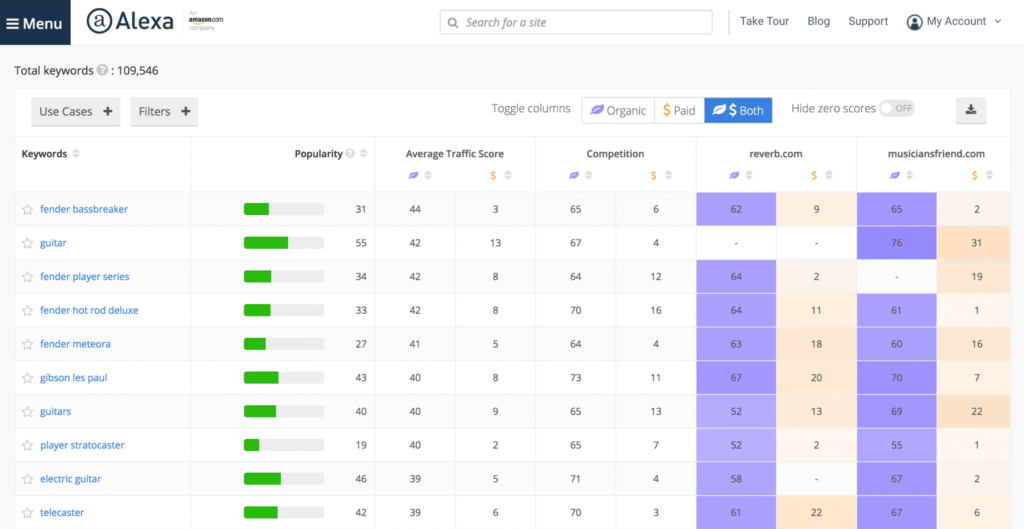Business, SEO, Social Media Marketing
9 Best Competitor Benchmarking Tools in 2020.
9 Best Competitor Benchmarking Tools in 2020.
How do you find out what your competitors are up to?
Things you might need: dark shades, trench coat, and night vision goggles. You know, the essentials if you were a cold war spy.
However, as a modern-day marketer, you can put away the fake nose and mustache because all you need is a computer and a strong internet connection.
Oh, and a few easy-to-use tools to do the job.
Choosing a competitor benchmarking tool
Competition is inevitable. It’s also not so fun to analyze, but ultimately it is crucial to have competitive intelligence as part of your marketing strategy. Luckily there are several competitor benchmarking tools that will do the work and keep an eye on your competitors for you.
We’ve curated a comprehensive list of competitor benchmarking tools to help you keep tabs on what your competitors are up to:
- Competitor benchmarking tools for social media
- Competitor benchmarking tools for SEO
- Competitor benchmarking tools for content
Competitor benchmarking tools for social media
In the ever-changing social media landscape, the one constant is competition. Your content quality and campaign performance shouldn’t just be measured in engagement rates but also compared to how they stack up against your competitors and industry standards.
What to look for in a competitor benchmarking tool for social media?
Below, we’ll go through the functionality you should look for when evaluating a competitor benchmarking tool for social media. Your new tool must be able to show you:
- Fan growth is an indicator of the followers you have gained over a set period. It is important to not just measure the new followers you have gained but also to compare and measure your competitors’ growth rate to see how you fare against them.
- Content frequency gives you insights on how often your competitors post on social media, the volume of content they have published, the ratio between videos, images, links, and so on. These insights will go a long way in helping you fine-tune your content strategy.
- Content engagement is an indicator of the impact your content is having. Insights into the engagement metrics of your competitors’ will help you understand which type of content gets them more engagement from their audience.
- Customer service stats like response rate & response times. These numbers help you answer questions on how many user posts your competitors responded to and how long it took for them to respond, how well are they replying to their fans, are they replying to every fan post and so on.
- Industry benchmarks give you a comprehensive look at the position of your brand in your industry and how you stack up against them.
- Competitive-set benchmarks give you a definitive look into the position of your brand against your direct competitors whom you compete within your industry.
- Regional benchmarks help you identify the position and performance of your brand against your direct competitors within a specific region.
- Share of voice gives you a definitive look at how much your brand dominates on a social network in comparison with your competitors. This will help you compare the volume of posts and engagement your competitors had received in a given period.
- Campaign intelligence helps you evaluate past campaign performances to make strategic decisions on your upcoming brand initiatives. By looking at your competitor’s campaign performance you get insights on engagement metrics, impressions, reactions, and so on to tweak your campaigns for better performance.
- Promoted post-detection: Paid social efforts help brands get more visibility than organic reach does. Knowing which posts your competitors are putting their money behind can help you build your social strategy and help you find the type of content your competitors prefer to use.
- Sentiment analysis helps you identify how a certain brand or post is perceived by people. By applying sentiment analysis on your competitor’s profile you can, to a certain degree, get an idea of how people had reacted to a competitor’s campaign and in turn borrow ideas from them to tweak yours. This also applies to solve consumer queries that your competitors haven’t by filtering posts based on negative sentiment they had received.
1. Falcon Benchmark
We might be biased here, but it’s our blog so we’ll put our solution at the top. ?
Ours is an AI-powered, brand-focused social media intelligence solution that helps companies gather reliable social media data to perform better on social.
This means creating more engaging content, obtaining certainty around your social strategy, and automating tedious tasks like reporting.
It provides a host of features that will help you analyze your brand’s social media performance and make better marketing decisions.
- You can dissect which type of your posts garner more engagement and at what time.
- Using the tool’s hashtag tracker, you can discover the most engaging hashtags used by your brand.
- You can also benchmark your social media performance against competitors from your industry.
Benchmark provides in-depth visual intelligence and analytics to help marketers decide which images engage best for their brand. The color and object analysis will help you discover content ideas by searching for branded social content based on dominant colors and/or objects used within images and analyze their performance. You can filter the results further based on industry and geography.
But here’s my personal favorite functionality:
Benchmark’s latest feature is the outliers detection functionality that helps find the nuggets of gold in your datasheet. You can detect posts that garnered the greatest number of likes, comments, shares, retweets, replies, and much more to help you discover the kind of posts/tweets that work in your industry. Now, how cool is that?
Pricing: Starting from $350 per month
G2Crowd Rating: 4.1
2. Phlanx
Phlanx is an Instagram engagement calculator that offers an array of features to help you keep an eye on your competitors. For starters, you get stats on the engagement rate, follower growth, audience demographics, brand mentions, and so on to help you track your competitors’ progress on Instagram.
The tool also has an Influencer Auditor feature that churns out reports of an influencer’s profile with their engagement rate, follower count, and more.
Pricing: Starting from $25 per month
G2Crowd Rating: N/A
Competitor benchmarking tools for SEO
Tracking your competitors is just as important as monitoring your search engine optimization. You need to know which keyword they rank for, which pages bring the most search engine traffic for them, what their top landing pages are, and so on to get ahead.
3. Ahrefs
Ahrefs is a powerful SEO tool that offers an array of features. The tool’s Site Explorer helps you find what keywords your competitors are ranking for and which pages bring the most search engine traffic for them. You can also see how much traffic each keyword brings them. This tool also helps you to assess the quality of your competitors’ backlink profiles.
Pricing: Starting from $99 per month
G2Crowd Rating: 4.6
4. SEMrush
SEMrush is yet another comprehensive SEO tool to help you keep an eye on your competitors. This tool helps you discover your competitors’ traffic volume, traffic source, mobile vs desktop traffic, top landing pages, subdomains, and much more.
In addition to that, you can also monitor your competitors’ marketing activities and strategies by looking for an audience overlap, identifying your competitors’ business connections, traffic sources, and so on. These features will not only uncover your competitors’ strategies but also help you fine-tune your content strategy.
Pricing: Starting from $99 per month
G2Crowd Rating: 4.5
5. Alexa
Amazon’s Alexa is an excellent SEO tool for competitive website analysis. This tool allows you to compare competitors’ website traffic, share of voice, keywords, backlinks, and much more. Alexa helps you discover which other sites share your audience to help you uncover new competitors and understand how they reach their audience more effectively.
In addition to that, Alexa helps you capture a larger share of voice among your audience by refining your SEM, SEO, and content strategy and pinpointing your competitors’ success tactics.
Pricing: Starting from $149 per month
G2Crowd Rating: 4.2
6. BuiltWith
BuiltWith is the tool to use to help you find what websites are built with. The best way to see how you fare against your competitors is to dissect how they have built their websites, what are the technologies they have used, and so on.
This tool allows you to get lists on websites that use a specific keyword and then further break it down by technology, location, spend, ranking, and more. You can also track the rise and fall of a specific technology and its usage across the web over the last 12+ years.
Furthermore, you can view the usage trends for a particular sector or group of technologies to get a snapshot of who the players are in each category and the market share held by each competing technology.
Pricing: Starting from $295 per month
G2Crowd Rating: 4.3
7. Crayon
Crayon is a market and competitive intelligence platform that helps you track a company’s entire digital footprint. Using Crayon, you can keep tabs on every move of your competitors, right from a pricing change, customer reviews to marketing campaigns, and more. The tool’s competitive analysis platform helps you filter all the noise to analyze and identify market trends.
Pricing: N/A
G2Crowd Rating: 4.6
Competitor benchmarking tools for content
As far as defining your brand’s content marketing strategy goes, it is considered incomplete without having intel on your competitors’ content marketing. Knowing a competitor’s best performing content, most engaging content, content tactics, and so on are valuable to fine-tune your content strategy.
8. Buzzsumo
BuzzSumo is a great tool to get content insights that best resonates with your audience. Their brand monitoring solution helps you to stay ahead of topics that are engaging with your audience. It also helps you create compelling content and keep a tab on what your competitors are up to.
Using Buzzsumo you can analyze what content performs best for any topic or competitor. Buzzsumo’s competitor research gives you insights into what content is getting traction for your competitors, what networks are they having success in, who is sharing their content, and much more. This is a comprehensive tool that offers an array of solutions to track your social and SEO footprint.
Pricing: Starting from $99 per month
G2Crowd Rating: 4.5
9. Similarweb
Similarweb helps you get visibility on the best performing content of any site to help you understand how to drive more engagement from your audience. This tool also reveals your competitors’ paid and organic keywords along with their traffic share ranks and landing pages.
Similarweb also masquerades as the Google Analytics of your competitors’ websites by revealing their website traffic, referral traffic, and much more. In addition to that, you also get intel on your competitors’ PPC and display advertising.
Pricing: N/A
G2Crowd Rating: 4.2
Final thoughts
To rise above the cut-throat competition, you’re going to need all the ninja-class tools possible to keep tabs on your competitors’ every move and always stay one step ahead.
The above-mentioned tools can help you with all of that and more. Based on your needs and what fits your budget best, you can now choose the tool or tools that will boost your social performance.

 العربية
العربية








